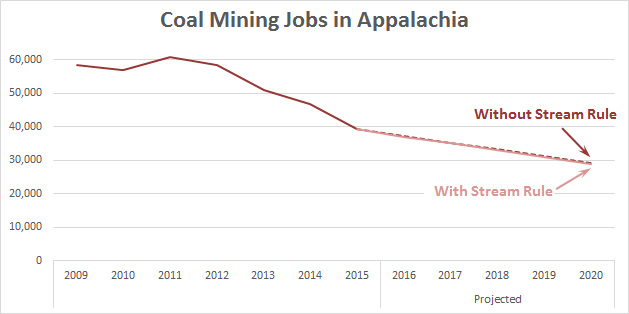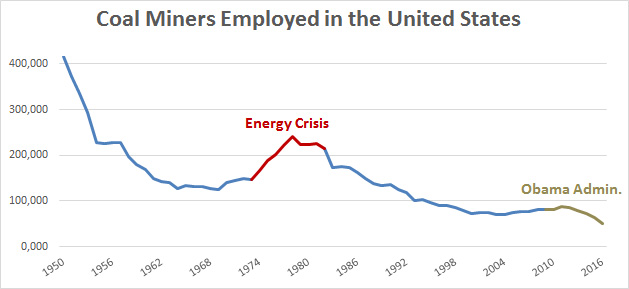Behold the politics of Donald Trump in a nutshell:
Talking to Trump voters here, several have said that Trump “put the miners back to work.” (They are referring to the stream rule rollback)
— Dave Weigel (@daveweigel) February 18, 2017
Weigel is in Florida, so the workers in question are mostly Appalachian miners. Here’s a quick look at Appalachian coal mining employment:1

This chart shows two things. First, coal mining in Appalachia has been plummeting for a long time. Decades, actually. So it’s pretty easy to see why Appalachian coal miners are in dire straits and eager to listen to someone, anyone, who sounds sympathetic to their plight.
Second, Trump is getting a lot of of attention for rolling back the Stream Protection Rule, but it’s not going to put anyone back to work. I had to cheat to even get it to show up on the chart. It’s responsible for maybe a hundred mining jobs out of a total decline of 30,000 between 2009 and 2020.
So who does benefit from rolling back this rule? Well, OSM figures that Appalachian mine owners will save about $24 million per year in compliance costs.3 So they’re pretty happy. This is a dynamic that we’re going to see over and over from Trump:
- He puts on a big show about something or other. Workers cheer.
- Offstage, it turns out the benefit to workers is minuscule.
- Instead, the bulk of the benefits end up going to corporations and the rich.
- Liberals will find out about this because the New York Times will probably write about it. Working-class Trump fans won’t, because none of it will be reported by Fox News or Drudge or Limbaugh or Breitbart.
Executive summary: workers get a pittance, the rich get rewarded, and streams and rivers will continue to be fouled by mine tailings. But Trump’s supporters will be happy because they’ll be kept in the dark by all the people supposedly looking out for them.
UPDATE: I’ve gotten several requests for a longer look at coal mining employment. Here it is.4 Please note two things: (1) this is for the entire US, not just Appalachia, and (2) it’s for coal miners, not total coal mine employment. You can’t compare it to the chart above.

1This is approximate. I counted coal mine employment from Pennsylvania, Ohio, West Virginia, Kentucky, and Alabama. The projection is based on a 50 percent loss of coal production and coal jobs between 2012 and 2020. The Office of Surface Mining figures that the Stream Protection Rule will cost about 260 mining jobs, and that Appalachia will bear 46 percent of compliance cost. (See this CRS report, p. 17.) So we can roughly figure that it will cost Appalachia a little over a hundred mining jobs.2
2The net job loss will be about zero, thanks to additional hires of engineers and biologists. However, that does nothing for miners.
3See here, p. 15. Total estimated compliance costs are $52 million per year, with Appalachia bearing 46 percent of the total.
4 Data for 1950-1985 from here. Data from 1985-2016 from FRED.













